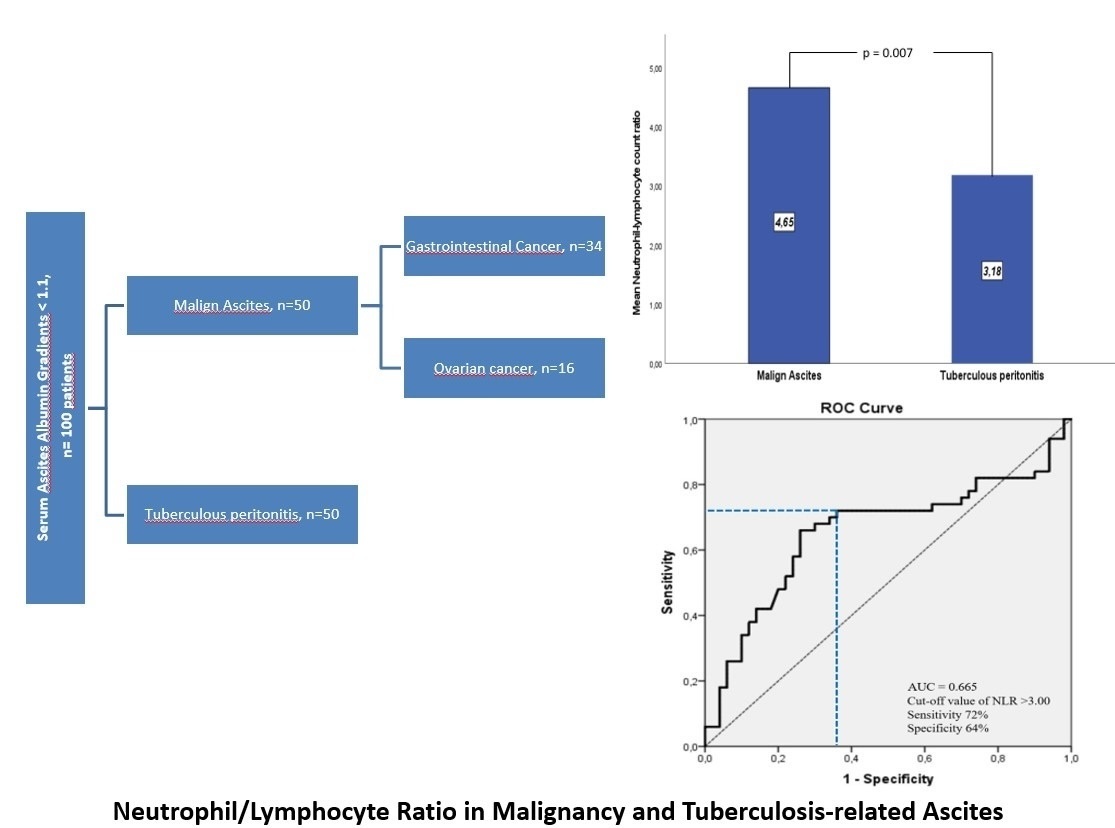Current issue
Archive
Manuscripts accepted
About the Journal
Editorial office
Editorial board
Section Editors
Abstracting and indexing
Subscription
Contact
Ethical standards and procedures
Most read articles
Instructions for authors
Article Processing Charge (APC)
Regulations of paying article processing charge (APC)
GASTROENTEROLOGY / RESEARCH PAPER
Is the Neutrophil/Lymphocyte Ratio a useful index in the differential diagnosis of Malignancy and Tuberculosis-related ascites?
1
Dicle University, Turkey
Submission date: 2024-11-10
Final revision date: 2025-04-14
Acceptance date: 2025-04-23
Online publication date: 2025-06-08
Corresponding author
Feyzullah Uçmak
Dicle University, Department of Gastroenterology, Dicle University S, 21180, Diyarbakir, Turkey
Dicle University, Department of Gastroenterology, Dicle University S, 21180, Diyarbakir, Turkey
KEYWORDS
TOPICS
ABSTRACT
Introduction:
Distinguishing between malignant ascites (MA) and ascites secondary to tuberculous peritonitis (TBpA) can sometimes be challenging for the clinician. Neutrophil-to-lymphocyte ratio has been shown to be a useful index of advanced disease and poor prognosis in patients with cancer. We investigated the suitability of the Neutrophil-lymphocyte ratio, an inflammatory biomarker, in differentiating MA and TBpA.
Material and methods:
Demographic and laboratory characteristics of 100 patients with confirmed diagnoses of malignant ascites and ascites secondary to tuberculous peritonitis between January 2015 and December 2020 were analyzed retrospectively. The diagnostic ability of NLR in differential diagnosis was evaluated.
Results:
Serum Neutrophil-lymphocyte ratio was significantly higher in patients with MA than in patients with TBpA (4.65 ± 3.17 vs. 3.17 ± 1.74, p=0.007). The area under the curve value was 0.655 (95% confidence interval=0.544–0.767, p = 0.007). The optimal threshold value for distinguishing malignant ascites from TBpA was determined to be NLR>3.00 (sensitivity 72.0%, specificity 64.0%, positive predictive value 66.7%, negative predictive value 69.6%, accuracy 68%). This threshold value was found to have better discrimination rates in the patient group over 40 years of age (sensitivity 70.0%, specificity 88.0%, positive predictive value 85.4%, negative predictive value 74.6%, accuracy 79.0%).
Conclusions:
NLR, a simple and rapid inflammatory index, can be among the initial diagnostic tests to distinguish MA and TBpA, especially in those older than 40 years of age.
Distinguishing between malignant ascites (MA) and ascites secondary to tuberculous peritonitis (TBpA) can sometimes be challenging for the clinician. Neutrophil-to-lymphocyte ratio has been shown to be a useful index of advanced disease and poor prognosis in patients with cancer. We investigated the suitability of the Neutrophil-lymphocyte ratio, an inflammatory biomarker, in differentiating MA and TBpA.
Material and methods:
Demographic and laboratory characteristics of 100 patients with confirmed diagnoses of malignant ascites and ascites secondary to tuberculous peritonitis between January 2015 and December 2020 were analyzed retrospectively. The diagnostic ability of NLR in differential diagnosis was evaluated.
Results:
Serum Neutrophil-lymphocyte ratio was significantly higher in patients with MA than in patients with TBpA (4.65 ± 3.17 vs. 3.17 ± 1.74, p=0.007). The area under the curve value was 0.655 (95% confidence interval=0.544–0.767, p = 0.007). The optimal threshold value for distinguishing malignant ascites from TBpA was determined to be NLR>3.00 (sensitivity 72.0%, specificity 64.0%, positive predictive value 66.7%, negative predictive value 69.6%, accuracy 68%). This threshold value was found to have better discrimination rates in the patient group over 40 years of age (sensitivity 70.0%, specificity 88.0%, positive predictive value 85.4%, negative predictive value 74.6%, accuracy 79.0%).
Conclusions:
NLR, a simple and rapid inflammatory index, can be among the initial diagnostic tests to distinguish MA and TBpA, especially in those older than 40 years of age.
Share
RELATED ARTICLE
We process personal data collected when visiting the website. The function of obtaining information about users and their behavior is carried out by voluntarily entered information in forms and saving cookies in end devices. Data, including cookies, are used to provide services, improve the user experience and to analyze the traffic in accordance with the Privacy policy. Data are also collected and processed by Google Analytics tool (more).
You can change cookies settings in your browser. Restricted use of cookies in the browser configuration may affect some functionalities of the website.
You can change cookies settings in your browser. Restricted use of cookies in the browser configuration may affect some functionalities of the website.



